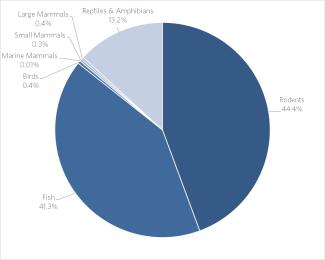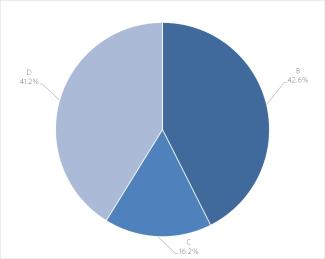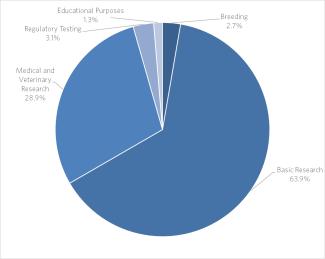In 2023, a total of 184,785 animals were involved in 443 research and teaching protocols at UBC.
The total is a 17 per cent increase compared to 2022. More than 80 per cent of that increase was due to an increased number of fish involved in UBC research in 2023.
By animal type
Rodents account for 44 per cent of the total number of all animals involved in research at UBC last year, and 98 per cent of the mammals. Small mammals, large mammals and marine mammals collectively represented less than one per cent of the total. The number of large mammals involved in research decreased from 796 in 2022 to 676 in 2023. Other animals involved in research were fish (41 per cent), birds (0.4 per cent), and reptiles and amphibians (13 per cent).
| Animal Type | Number | Percentage |
| Rodents | 82,001 | 44.4% |
| Fish | 76,286 | 41.3% |
| Reptiles/Amphibians | 24,404 | 13.2% |
| Birds | 831 | 0.4% |
| Small Mammals | 571 | 0.3% |
| Large Mammals | 676 | 0.4% |
| Marine Mammals | 16 | 0.01% |
| Total | 184,785 |

How were the animals involved in research?
The Canadian Council on Animal Care divides animal research into five Categories of Invasiveness (A to E).
Category A includes most experiments involving tissue cultures, eggs and single-cell organisms and does not require annual reporting.
59 per cent of animals involved in research at UBC in 2023 fall under categories B or C. The invasiveness ranges from little discomfort and stress to minor stress and pain. For a wide range of animals this could include observation in the wild, brief periods of restraint for tagging, taking blood samples and minor surgical biopsies under anesthesia.
In Category D studies, rated for moderate to severe distress or discomfort, the proportion of animals involved in the category in 2023 fell to 41% per cent of the total. The total of 76,104 in 2023 is an increase from 75,485 in 2022.
No animals were involved in a category E study.
| Category | Number | Percentage |
| B | 78,659 | 42.6% |
| C | 30,022 | 16.2% |
| D | 76,104 | 41.2% |
| E | 0 | 0.0% |
| Total | 184,785 |

By purpose
The Canadian Council on Animal Care (CCAC) divides the purposes for which we involve animals into six categories.
Purpose 0: Breeding
The number of animals in research involving breeding was 5,008 in 2023, compared to 2,941 in 2022.
Purpose 1: Basic Research
64 per cent per cent of animals were part of UBC’s inquiries in scientific disciplines that include biology, psychology, physiology and biochemistry. The number of animals involved in Basic Research increased by 19 per cent compared to 2022 (118,153 in 2023, compared to 99,132 in 2022).
Purpose 2: Medical and Veterinary Research
This involvement of animals provides treatments for diseases that improve health care outcomes for both humans and animals. In 2023 there was a 9 per cent increase in the number of animals involved in this category, compared to 2022. (53,462 in 2023, compared to 49,142 in 2022.)
Purposes 3 and 4: Regulatory Testing
Canadian law dictates that animals be research models before humans in regulatory trials for drugs and general medical products. That requirement includes vaccines and medical hardware such as stents and heart valves. UBC makes every effort to minimize the number animals involved in regulatory testing. In 2023, 3 per cent of animals were involved in this area at UBC.
Purpose 5: Educational Purposes
Educational involvement of research animals includes several fields of study at UBC. The involvement of animals in teaching at UBC must be approved by individual faculties and the University Senate. Where possible, vertebrate animals are replaced by invertebrates. A little over 1 per cent of animals involved in UBC research were for educational purposes in 2023.
| Purpose | Number | Percentage |
| 0 (Breeding) | 5,008 | 2.7% |
| 1 (Basic Research) | 118,153 | 63.9% |
| 2 (Medical and Veterinary Research) | 53,462 | 28.9% |
| 3,4 (Regulatory Testing) | 5,718 | 3.1% |
| 5 (Educational Purposes) | 2,444 | 1.3% |
| Total | 184,785 |
